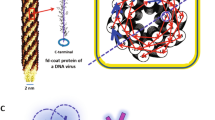Abstract
While the phenomenon of like-charge attraction of DNA is clearly observed experimentally and in simulations, mean-field theories fail to predict it. Kornyshev et al. argued that like-charge attraction is due to DNA's helical geometry and hydration forces. Strong-coupling (SC) theory shows that attraction of like-charged rods is possible through ion correlations alone at large coupling parameters, usually by multivalent counterions. However for SC theory to be applicable, counterion-counterion correlations perpendicular to the DNA strands need to be sufficiently small, which is not a priori the case for DNA even with trivalent counterions. We study a system containing infinitely long DNA strands and trivalent counterions by computer simulations employing varying degrees of coarse-graining. Our results show that there is always attraction between the strands, but its magnitude is indeed highly dependent on the specific shape of the strand. While discreteness of the charge distribution has little influence on the attractive forces, the role of the helical charge distribution is considerable: charged rods maintain a finite distance in equilibrium, while helices collapse to close contact with a phase shift of π, in full agreement with SC predictions. The SC limit is applicable because counterions strongly bind to the charged sites of the helices, so that helix-counterion interactions dominate over counterion-counterion interactions. Thus DNA's helical geometry is not crucial for like-charge DNA attraction, but strongly enhances it, and electrostatic interactions in the strong-coupling limit are sufficient to explain this attraction.
Graphical abstract

Similar content being viewed by others
References
E. Trizac, J.-L. Raimbault, Phys. Rev. E 60, 6530 (1999).
E. Trizac, Phys. Rev. E 62, R1465 (2000).
J.C. Neu, Phys. Rev. Lett. 82, 1072 (1999).
J.E. Sader, D.Y. Chan, J. Colloid Interface Sci. 213, 268 (1999).
J. Widom, R.L. Baldwin, J. Mol. Biol. 144, 431 (1980).
R. Podgornik, D. Rau, A. Parsegian, Biophys. J. 66, 962 (1994).
V.A. Bloomfield, Curr. Opin. Struct. Biol. 6, 334 (1996).
L. Guldbrand, B. Jönsson, H. Wennerström, P. Linse, J. Chem. Phys. 80, 2221 (1984).
N. Grønbech-Jensen, R.J. Mashl, R.F. Bruinsma, W.M. Gelbart, Phys. Rev. Lett. 78, 2477 (1997).
E. Allahyarov, I. D'Amico, H. Löwen, Phys. Rev. Lett. 81, 1334 (1998).
M. Deserno, A. Arnold, C. Holm, Macromolecules 36, 249 (2003).
R. Messina, J. Phys.: Condens. Matter 21, 113102 (2009).
A.A. Kornyshev, S. Leikin, J. Chem. Phys. 107, 3656 (1997).
A.G. Cherstvy, J. Phys.: Condens. Matter 17, 1363 (2005).
A.G. Moreira, R.R. Netz, Europhys. Lett. 52, 705 (2000).
A.G. Moreira, R.R. Netz, Phys. Rev. Lett. 87, 078301 (2001).
A.G. Moreira, R.R. Netz, in Electrostatic Effects in Soft Matter and Biophysics Vol. 46 of NATO Science Series II - Mathematics, Physics and Chemistry, edited by C. Holm, P. Kékicheff, R. Podgornik (Kluwer Academic Publishers, Dordrecht, NL, 2001).
A. Naji, A. Arnold, C. Holm, R.R. Netz, Europhys. Lett. 67, 130 (2004).
M. Kanduč, J. Dobnikar, R. Podgornik, Soft Matter 5, 868 (2009).
A. Arnold, C. Holm, Eur. Phys. J. E 27, 21 (2008).
R.R. Netz, Eur. Phys. J. E 5, 557 (2001).
M. Kanduč, A. Naji, R. Podgornik, J. Chem. Phys. 132, 224703 (2010).
A. Naji, R. Netz, Eur. Phys. J. E 13, 43 (2004).
S. Kesselheim, W. Müller, C. Holm, Phys. Rev. Lett. 112, 018101 (2014).
A. Arnold, O. Lenz, S. Kesselheim, R. Weeber, F. Fahrenberger, D. Röhm, P. Košovan, C. Holm, in Meshfree Methods for Partial Differential Equations VI, Vol. 89 of Lecture Notes in Computational Science and Engineering, edited by M. Griebel, M.A. Schweitzer (Springer, 2013) pp. 1--23.
H.J. Limbach, A. Arnold, B.A. Mann, C. Holm, Comput. Phys. Commun. 174, 704 (2006).
A. Arnold, C. Holm, J. Chem. Phys. 123, 144103 (2005).
J.D. Weeks, D. Chandler, H.C. Andersen, J. Chem. Phys. 54, 5237 (1971).
D. Frenkel, B. Smit, Understanding Molecular Simulation, second edition (Academic Press, San Diego, 2002).
Author information
Authors and Affiliations
Corresponding author
Rights and permissions
About this article
Cite this article
Kuron, M., Arnold, A. Role of geometrical shape in like-charge attraction of DNA. Eur. Phys. J. E 38, 20 (2015). https://doi.org/10.1140/epje/i2015-15020-9
Received:
Revised:
Accepted:
Published:
DOI: https://doi.org/10.1140/epje/i2015-15020-9




